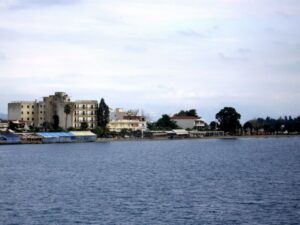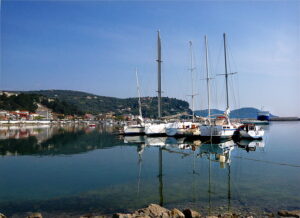Central Evia
Starting from Chalkida, we follow the coast road south-eastward towards Aliveri, coming first to the villages of Mytikas and Vasiliko.
At VASILIKO, there is a Frankish tower, with two more a short distance away on hills affording fine views of the entire plain and the sea.
At the nearby community of PHYLLA is the Venetian castle of Likario (13th-15th c.)
LEFKANTI – MALAKONDA
The sea-side settlements of LEFKANTI and MALAKONDA have a good swimming and a large number of facilities.
Archaeological excavations in this area have brought to light some important finds from settlements dating from prehistoric times to the Geometric period.
ERETRIA
We proceed to ERETRIA, the second largest port on Evia after Chalkida, from which there are connections with Attica on the mainland.
Eretria spreads along the coast above the ruins of the ancient city.
Ancient Eretria was built in the 8th c. BC and became a prosperous city. In 490 BC it was destroyed by the Persians, but quickly recovered and took part in the naval battle of Salamis, on the side of the Athenians (480 BC). It was destroyed by the Romans in 198 and 97 BC, and fell into obscurity.
In the archaeological site at Eretria can be seen: a covered house with mosaic floors (4th c. BC), ruins of the east fortification wall of the ancient acropolis, ruins of the ancient theater and palaestra on the lower slopes of the acropolis, the temples of Dionysos and Demeter and the sanctuary of a female deity on the south side of the acropolis, next to the theater.
There are also the ruins of the large temple of Apollo Daphnephoros, roughly in the center of the archaeological site, remains of the temple of Isis, the palaestra, the gymnasium, houses and tombs at Livadia, by the sea.
The Archaeological Museum contains important finds from the excavations at Eretria, Amarynthos and Lefkanti.
The Municipality of Eretria organizes a cultural and athletic festival at the end of July – beginning of August.
The area of Eretria has many hotel units, restaurants, bars, entertainment centers, and facilities for a variety of water sports.
There is a bungalow complex on the pine-clad islet of Pezonisi to right of the harbor.
The island is connected to the town by a bridge.
Central Evia
AMARYNTHOS
After Eretria, we come to AMARYNTHOS, a beautiful seaside town with fine beaches and restaurants and fish taverns.
Here you find abundant freshly-caught fish and seafood delicacies displayed in the local fish shops all along the waterfront.
The natural beauty of its landscape with its dreamy waters and golden sandy beaches and also its excellent infrastructure are some of the advantages of this town.
The town stretches along the coast and has been developed as a tourist tourist over the past few years.
There are numerous hotels, apartments and rooms to let providing all comforts, as well as fish taverns, snack bars, coffee shops and night clubs for the young.
Amarynthos is also ideal for walks and excursions as well as visits to small churches that are monuments for the history of the place.
It is worth visiting the Cathedral of the Annunciation of the Virgin Mary which is situated in the city of Amarynthos and constructed of chiseled stone.
The icon is mainly made of marble.
Amarynthos has also a Folklore Museum with an interesting collection.
The first permanent settlement of Amarinthos is dated during the Neolithic Period (6000-3000 B.C).
One of the most important settlements, however, was the one developed on the coast of Evia during the Bronze Age (3000 – 2100 B.C).
A small side-road leads to Ano Vathia, a traditional village built on a ravine and surrounded by verdant hills.
A short distance away is the nunnery of Agios Nikolaos, in a superb natural setting.
The nunnery church has some 16th c. wall-paintings.
ALIVERI
To the east lies ALIVERI, a town in which there is a considerable commercial activity, to the south-east of which is a thermo-electric station.
In the area, there is also marble mining industry.
Aliveri also boast the picturesque harbor of Karavos.
Central Evia
After this we come to RIZOKASTRO, one of the earliest castles of the Frankish period.
A Mycenaean “tholos” tomb was discovered in the area of Katakalos, 7 km. to the north-east. The important wetland of Dystos is just a short distance away.
AVLONARI
Beyond Aliveri the road leaves the sea and continues inland towards Lepoura, after which it turns north to Avlonari, pass through a fertile plain with many crops.
AVLONARI is a beautiful traditional village that spreads around a hill with a superb view over the plain.
There is a Venetian tower and church at the top of the hill.
At Chania Avlonariou is the Byzantine church of Agios Dimitrios, which has some 13th c. wall-paintings.
Other beautiful villages in the area, surrounded by lush greenery include Agios Georgios, Agios Vlassis, Orologio, Monodry, Konistres, Oxylithos, Taxiarches and Pyrgos.
Most of these are built on heights, enjoy wonderful views over the plane and the sea and have attractive houses and carefully kept gardens.
The road forks at Chania Avlonariou, with one branch going down to the coast and Stomio and Platana, traditional settlements that extend along an endless shore, with ample accommodation, taverns and entertainment centers of all kinds.
It ends at the beach of Kymi, an important harbor connecting Evia with Sporades islands and Volos, with numerous hotels, apartments and studios to let, taverns and coffee shops.
Central Evia
KYMI
The other branch of the road continues inland and leads to the beautiful town of KYMI, the “balcony over the Aegean”, as it is known, because of its superb view over the boundless sea (44km. from Eretria and 91 km. from Chalkida).
It is built around the slopes of a hill with lush vegetation.
A twisting road 4 km. long connects the town with the beach of Kymi, which has several traditional houses, picturesque streets, fine gardens, an abundance of running water and some rich traditions.
In ancient times this was one of the most important cities on Evia and founded colonies in South Italy and Asia Minor (8th c. BC).
Kymi has a very interesting Folklore Museum, with exhibits covering the period 1800-1930.
A special room contains relics of Georgios Papanikolaou, a doctor and researcher of worldwide renown.
In the town you will find many hotels and rooms to let, taverns, restaurants, coffee shops and bars.
Central Evia
Choneftiko, 2 km north-west of Kymi, has a mineral spring of drinking water and lush greenery.
To the west of Kymi is the superb beach of Chiliadou and the traditional village of Lamari.
The mountain village of STROPONES, in the foothills of Mount Dirphi, is in the interior of Evia, south-west of Kymi. The village has abundant running waters, fruit trees, garden produces and chestnut and plane trees.
Just to the south is STENI DIRPHIS, a picturesque village built in a ravine full of plane trees in the foothills of Mount Dirphi. This entire area at the heart of the island is enchanting.



